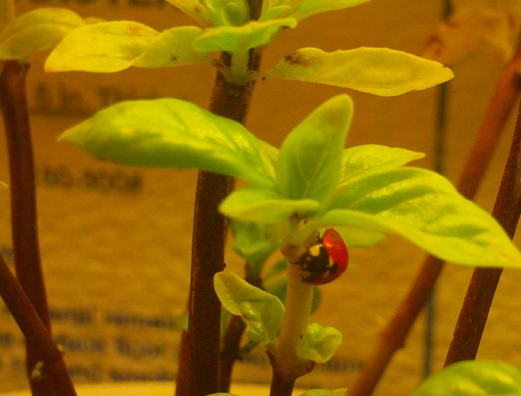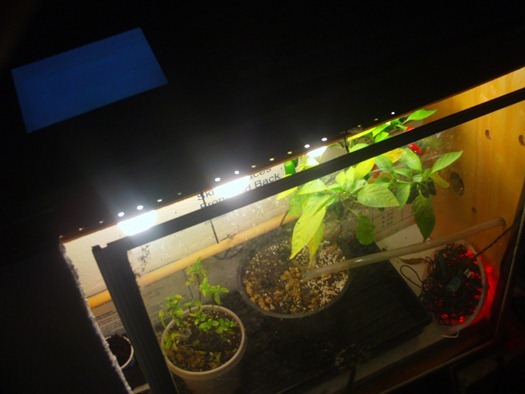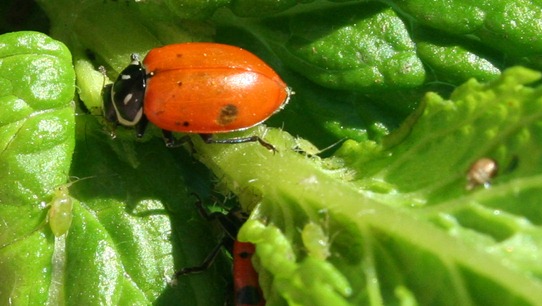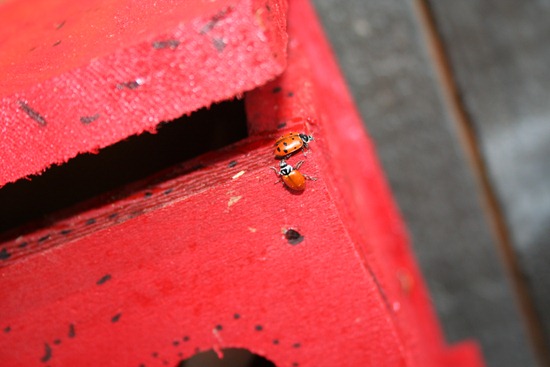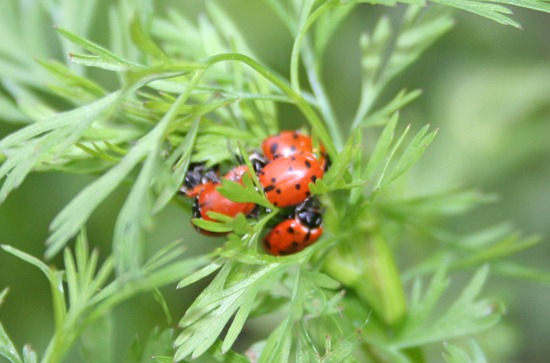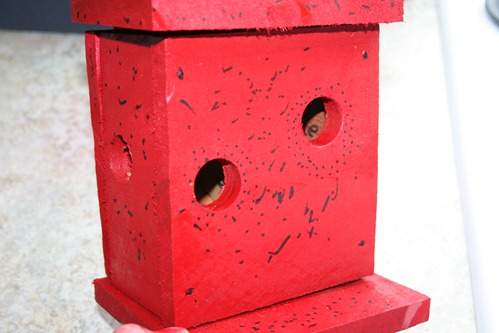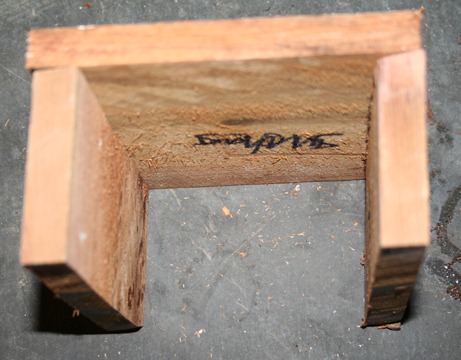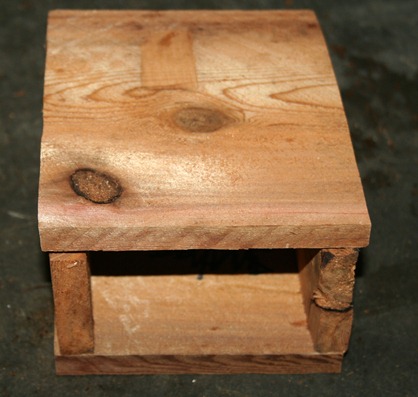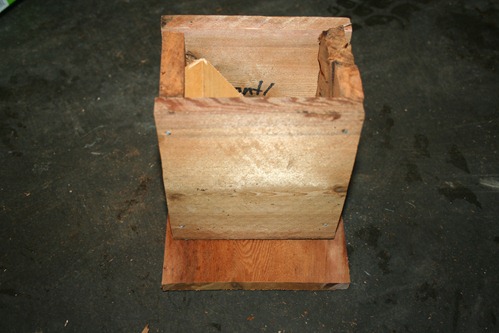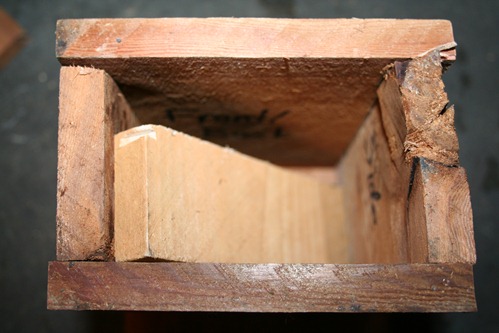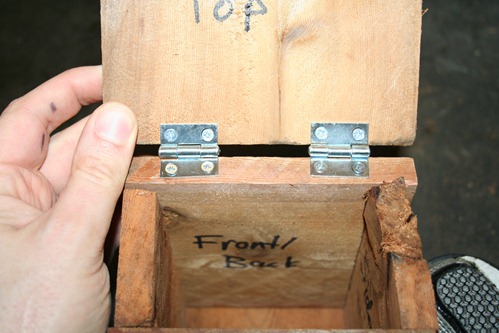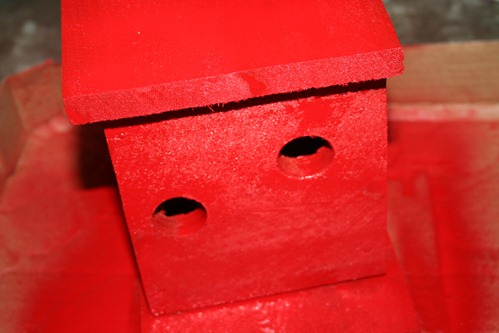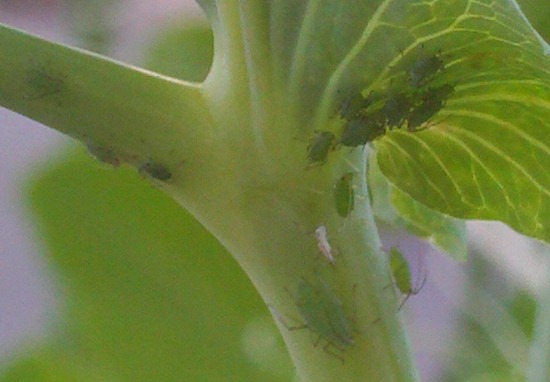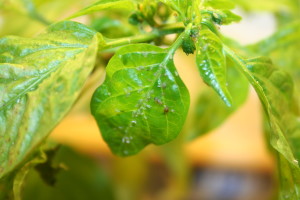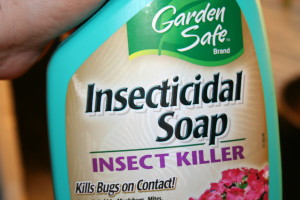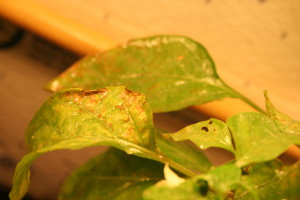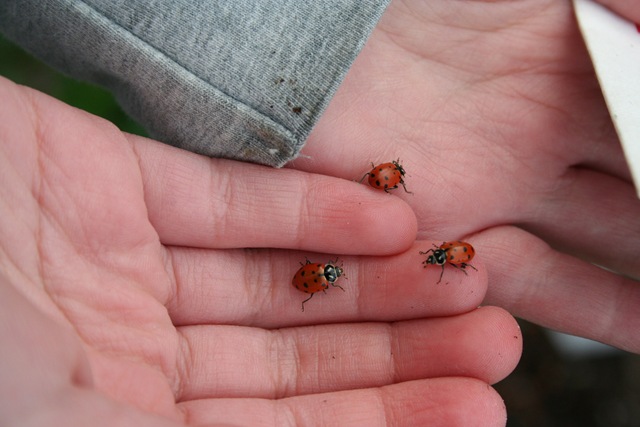Ladybug in the grow box
13.6 years ago indoor growbox, jalapeno, ladybugs
One problem with growing plants indoors is you don’t always get the benefits of beneficial insects, but as you can see above it doesn’t always have to be that way. At least one little lady bug snuck into the grow box and seems to have found some snacks on a basil plant.
If anyone is curious I also have one of my jalapeno pepper plants in the grow box with hopes of getting a few more ripe red jalapeno peppers before things get too cold.
Ladybug Release: Not a good day to be an aphid in my garden
13.9 years ago aphids, ladybugs
We normally would have already had our annual ladybug release for aphid control, though this year it has been a little colder than normal so we have to postpone until this evening. You want to release your ladybugs at sunset since they do not like to fly at night and gives you the best odds of keeping them in your garden.
For fun and a little carnage we decided to let 20-30 out early and placed them on some plants with a few too many aphids (peas and mint) In the picture above fortunately (or unfortunately depending how much you loathe aphids) you can’t see it but the ladybug was just having his first victim. With many more to come that were surrounding him (or her).
For some less gruesome pictures of ladybugs you can check out some of the photo shoots from our previous years ladybug releases
Tags: aphids, ladybugs, little green bugs
Build a ladybug house
13.9 years ago aphids, cheap, kids, ladybugs
With a piece of cedar fence board and a few nails you can make your own ladybug house to give your army of aphid eaters I nice comfortable place to take shelter between battles
This project started with my youngest daughter (5 years old) has been asking every weekend, “Can we build something with wood?” Finally I came up with this project which we had a great time building.
Materials
- 1 — Cedar fence board
- about 12 finishing nails
- small hinge
- 1/2-3/4 drill bit
- paint for decorating (optional)
Build instructions
Step #1 – Cut the boards: Given the cedar board should be 5-1/2 inches so the cuts should be pretty straightforward. Cut the following pieces:
- Front Panel — 5.5” by 5”
- Back Panel — 5.5” by 5”
- Bottom Panel — 5.5” by 5”
- Top Panel — 5.5” by 4”
- 2 X Side Panel — 5.5” by 2.5”
- Room Separator — 5.5” by 1”
I used a circular saw for my cuts…yes I really should invest in a chop saw or table saw so hopefully your cuts will be a little straighter but I am sure the ladybugs will not mind.
Step #2 — Nail two sides to back panel
Step #3 — Nail front to sides and back panel
Step #4 — Nail bottom panel to ladybug house.
Step #5 — Drop room separator inside house.
Ladybugs are social and like to group together but sometimes thy like to live in smaller groups, this divider will give an additional area for the ladybugs to hang out.
Step #5 — Attach top using screws and hinge
Step #6 — Drill 3-4 holes into front and sides and decorate (optional)
Step #7 — Hang close to your garden
Now of course the decoration part is optional unless you are a 5 year old then it is required. Here she is carefully deciding what to paint with her marker next…
Tags: aphids, little green bugs
Little green bugs on pea plants
13.9 years ago aphids, ladybugs, organic, peas
It is fairly uncommon for me to see these little green bugs on my peas. In case you didn’t guess these are pea aphids, which suck juices from the plant leaves ad spread disease between plants. This is a rare occurrence because normally it is warmer and drier this time of year and we would have our annual ladybug release to take care of these little pests. If the weather holds up we should have good enough weather to do the ladybug release next weekend.
In the meantime I have resorted to to using some organic pesticide solution to deter these pests until the weather gets better. This will not stop the aphids, but hopefully slow the down a little, though when it comes to organic solutions you can not compete with ladybugs which each one can eat up to 5000 aphids/mites in their lifetime. Come next weekend there will be an aphid massacre in the garden. [evil laugh]
Tags: aphids, little green bugs
Getting rid of aphids on pepper plants
14.9 years ago aphids, brown spots, ladybugs, peppers
It can be difficult getting rid of aphids on plants in your garden. Fortunately you can get rid of those aphids with materials you have in your kitchen.
First of all I am a little embarrassed that I let the infestation get this bad before noticing. I unfortunately set the grow box to have the sunrise at 1:00am and the lights always were off by the time I got home. Though the cause is not as important as how to get rid of them.
If this plant was outside my local lady bug population would have kept these buggers in check though they seemed to thrive without the vicious predators. For an outdoor plant a quick high pressure spray of water on the the leaves (as well as underside of leaves) would take care of the problem. Though this does not kill the aphids, they will starve to death before they make it anywhere to do any more damage.
This has not been my first battle with aphids, so fortunately I had some insecticidal soap on hand. I sprayed the entire plant from the top and bottom. I removed the major yellowing leaves and did another quick spray. Now if you don’t have any insecticidal soap, or just want to save $5 on buying a bottle here are a couple of proven recipes:
Simple Aphid Killer Spray
- 1 tsp dishwashing soap
- Fill 32 oz spray bottle with water
Directions:
Shake and spray liberally on tops and bottom of leaves ensuring aphids are covered completely.
Complex Aphid Killer Spray
- 1.5 tablespoon baking soda
- 1 tablespoon Murphy’s Oil Soap
- 1 tablespoon Vegetable Oil
- 1 tablespoon Vinegar
- 1 gallon water
Directions:
Pour into spray bottle and spray liberally on tops and bottom of leaves ensuring aphids are covered completely.
Extra Spicy Aphid Killer Spray
- 3 hot peppers chopped finely
- 1 quart of water
Directions:
Mix peppers with water and let seep overnight. Strain and pour into spray bottle and spray liberally on tops and bottom of leaves ensuring aphids are covered completely. WARNING: You care not to get this spray in your eyes.
US Department of Agriculture Mix
- 2 tsp dishwashing soap
- 1 cup of vegetable oil
- Fill 32 oz spray bottle with water
Directions:
Shake and spray liberally on tops and bottom of leaves every 9-10 days, ensuring aphids are covered completely.
If none of these solutions work, squish those buggers with your fingers being sure to include a sinister laugh while doing it. Which even if you are squeamish, this is what you will see if you let them have their way.
Tags: grow lights, growbox, outdoor plants, pepper plants, vegetables
3rd Annual Ladybug release
15 years ago aphids, kids, ladybugs
In case you missed the first and second annual lady bug release, you can follow those posts. We have never had a serious aphid or spider mite problem and I like to feel our annual release of lady bugs is the reason why. Either way, great entertainment for the girls for a couple hours for a $6.00 bag of lady bugs.
Lady bugs sometimes naturally choose to wander from the location where you release them and may just take residence in your neighbors yard, so I have thought about releasing them in my neighbors yard so they will end up in mine. Fortunately there are a few tricks to help entice your lady bugs from leaving your garden.
Give them a nap. Before you release them put them in your refrigerator for at least a couple hours. This will make them go asleep (dormant) until you are ready to release them. This way when you bring them outside in their sleepy stupor they may be more inclined to check out your garden before heading over your neighbors.
Feed them. After watering your garden before releasing them spray the ground with some sugar water. This will entice them to feast on that while waiting for a the aphids and spider mites to show up.
Choose the right time. Put your lady bugs out as the sun is falling and ensure that they are shaded from sun when releasing. This will prevent them from hiding from the hot sun and possibly finding a new place to make home.
Encourage your neighbors to have their own lady bug releases. One of our friends and neighbors had a great time with their girls releasing lady bugs last year and fortunately they are close enough that we may be sharing some bugs from both of our releases.
In the past I have had good results with the releases maybe seeing 30-40 lady bugs still crawling around on my plants the next day. This year had great results with hundreds of lady bugs in my aphid killing army.
Tags: cheap, outdoor plants, vegetables
